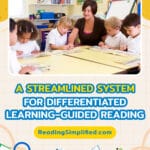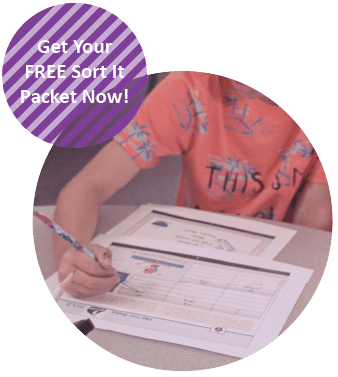
When I was a new teacher, I came home tired.
Dead tired.
My husband wanted to support me, to treat me, so he would offer to take me out to eat for dinner.
How sweet!
He would innocently ask, “Where would you like to go?”
Then I would despair.
Yes, dear readers, the thought of even having to choose between one of 5 choices of restaurants in our small town overwhelmed me.
(First world problem, yes.)
But why did I react so strongly?
Decision fatigue.
An instructional day with a constant stream of choice after choice.
Choices about instruction. (We had no curriculum! Have ya been there?)
Choices about student behavior.
Choices about grading.
Choices about copying.
To copy or not to copy, that was the question.
I feel for today’s teacher – even more than I emphasize with my old teacher-self.
I didn’t have the distractions of Google, Facebook, Pinterest, and Teachers Pay Teachers to contend with.
These platforms are dreamy in terms of possibilities.
But – they can also feel suffocating when we have too many decisions to make.
Listen to this –
A recent study calculated that teachers have at least 205 trillion instructional options.
That…ummm…could be considered challenging.
Ever find yourself drifting aimlessly in the internet sea?
You want to make wise decisions for your students – but with so many choices and learning differences…
…Where do you begin?
Combat Decision Fatigue with a Proven Framework for Small Group Guided Reading
To combat decision fatigue – AND to help you accelerate all of your readers’ – I’m sharing a small group, guided reading structure that has served me well for nearly 20 years.
This structure is designed to simplify planning – while enabling you to tailor lessons and differentiate your groups effectively.
I’ve used this structure as a tutor with hundreds of children, ages as varied as 3 to 15.
It’s also similar to the structure of an early intervention called the Targeted Reading Intervention I developed at the University of North Carolina that had a significant impact on all reading measures (decoding, word identification, spelling, and comprehension) as reported in these studies: (study 1, study 2, study 3, and study 4).
(This structure is generally fitting to any student at a K-3 reading level or any student of any age needing decoding, word identification, or fluency remediation.)
In this post, you’ll see specific examples of how to plan for 2 distinct groups.
The 3-Component Guided Reading Framework
In the Reading Simplified context, we consider 3 critical components of a strong, comprehensive small group guided reading session:
- Re-Reading
- Word Work
- Guided Oral Reading

Component #1 Re-Reading
Re-Reading for Fluency is just like it sounds.
The students re-read a book or selection of text several times until they have expanded their knowledge of high-frequency words, quickened their reading rate, and gained confidence and motivation in their reading.
To help them succeed, you model fluent reading while the students follow along. (We fade out this component when students are above grade level and fluent at about middle school reading levels.)
Component #2 Word Work
Word Work is the time for focusing on sound-based decoding and spelling for the end purpose of rapid acquisition of word identification.
Here at Reading Simplified, we recommend only a handful of activities that integrate multiple reading sub-skills simultaneously:
Concept of the alphabetic principle the alphabetic principle (that our written language is a code for sounds),
Left-to-right directionality,
Phonemic awareness (perception of individual sounds in words, i.e., “much” = /m/ /u/ /ch/).
Letter-sound knowledge Letter-sound knowledge (i.e, that “c” is usually /k/, “ow” is often /oa/, and “tch” is usually /ch/,
Decoding strategies, such as Blend As You Read and Flex It,
Spelling strategies, such as Write & Say
Multisyllable strategies, such as Blend As You Read by Chunk.
These reading sub-skills are integrated into just these handful of activities:
(For advanced readers, Word Work can also morph to emphasize vocabulary meanings and Greek and Latin roots.)
Component #3 Guided Reading
Guided Reading is when the students take turns reading aloud a challenging text that builds their decoding and word identification skills.
Here, you offer word-level and comprehension support where necessary.
Finally, students conclude the small group session by summarizing what they read and preparing to work independently with their targeted sound (such as /oa/) and texts for re-reading practice.
And that’s it. 🙂
The mission of this small group structure is to move ALL students to rapid acquisition of independent reading.
Once kids can read independently and enjoy reading for its own sake, then other structures may be beneficial, such as literature circles, genre study, book clubs, research studies, etc.
And while students are learning to read, teachers should be spending time reading aloud to children, having discussions about what’s being read, and writing in response to reading, first with a lot of teacher modeling and group writing.
But that’s a post for another day.
Most K-3 students, as well as struggling students, however, would benefit from the above structure to efficiently advance their reading skills and enjoyment.
So, when using this structure – you don’t have to decide what to do at the beginning, middle, and end of every 20 minute interaction with every group.
Sigh of relaxation.
Instead, you have a framework that hits the most important tasks of early literacy and adapts them to each group’s particular needs.
Bigger sigh of relaxation…
How to Plan an Effective Small Group Lesson: Group 1
Imagine a teacher.
We’ll call her Ms. Peregrine.
Ms. Peregrine teaches 1st grade and has 5 groups of students for her small group guided reading time.
She sees 2 of these groups every day – two of these groups every other day – and the final group 1-2 times per week.

Let’s take a closer look at how Ms. Peregrine organizes her daily meetings with two separate groups…
She begins making notes in her small group planner for Group #1 – AKA the “gymnasts.”
Based on her initial assessments of their reading achievement, they are at the Kindergarten reading level.
She’s placed them at the earliest Consonant-Vowel-Consonant (CVC) step and they've just been exposed to short “a” and short “i”.
They have good comprehension of text that’s read aloud to them.
Her main objective:
To rapidly provide them with a foundation of strong decoding skills so they can learn to recognize words easily, become fluent, and learn to love reading independently.
So, on the Reading Simplified Streamlined Pathway for Kindergarten level readers, this puts them at the first CVC level.

Background: The Reading Simplified Streamlined Pathway is our version of a scope and sequence for teaching anyone who is a young reader or a reader who is struggling.
The Streamlined Pathway incorporates:
Phonemic awareness,
Letter-sound knowledge,
Decoding strategies,
High-frequency word knowledge, and
Fluency
Using the Streamlined Pathway, coupled with the simple structure you’re viewing today for small group guided reading, you can diagnose and plan small group and independent work more easily and – with less effort.
Despite this time savings, you can also expect to see students reading achievement outcomes accelerate.
How 'bout them apples!
So as Ms. Peregrine begins thinking about her lesson, she’s already grounded by the 1st CVC level—the letter-sounds, Fry high frequency words, and decoding strategies that are emphasized there.
Specifically, over the course of 1-2 weeks, she’ll focus on these sounds:
Short vowels a i
Consonants c m p t s n h d w
Consonant digraphs th ch wh ll tt
Then she moves on to the specifics of her lesson:
Re-Reading for Fluency (Group 1)

The first step in the guided reading framework is – Re-Reading for Fluency.
What will Ms. Peregrine choose for her students to read?
Easy, quick decision.
She just adds the name of yesterday’s Guided Reading text, “Pig Sits” by Nora Gaydos to the Re-Reading for Fluency box because she had the gymnasts group re-reading it in pairs yesterday after their time with her.
Most of them should be able to read this short text fairly well to her now.
Word Work (Group 1)
The third and final step in the guided reading framework is – Guided Reading.
Since Ms. Peregrine has already determined that blending 3-sound words and learning the short “i” sound are the most pressing needs of the gymnast group, she flips through her short “i” CVC tub of books and selects 4 copies of the “Big Hit,” by Starfall.com.
Now she’s ready with a great plan for her most struggling group of readers.
Less than 5 minutes of effort to plan and…
With. No. Stress.
…Another sigh of pleasure.
How to Plan an Effective Small Group Lesson: Group 2
Our brave heroine, Ms. Peregrine, is now ready to plan for her other daily group – the Swimmers.
This group tested at the early 1st grade level, so Ms. Peregrine has placed them at the second step of the 1st Grade Streamlined Pathway.
As she prepared to make her next instructional decision, she considered four key factors:
These students are familiar, but rusty, with their short vowels.
Their Blend As You Read strategy is developing well with CVC words.
They know several high frequency words, too, but not all that would be expected for her school for early 1st grade.
Comprehension of text read aloud to them is good.
(All students are sorted into 1 of 3 Streamlined Pathways: K, 1st Grade, or 2nd Grade and Up. Yes – I’ve even taught struggling high school students and an adult who was functionally illiterate with a pathway like the 2nd Grade and Up one.)By just having 3 Pathways to choose from, Ms. Peregrine minimizes The Overwhelm.
These 1-pager pathways are much simpler than the endless standards, basal scope and sequences, and district guidelines she used to stress over.
And the best part?
With this efficient approach – her students will likely learn to read more quickly.
Given that Ms. Peregrine selected Level 2 on the Streamlined Pathway, she knows she’s focusing on:
➡ The long “o” sound and its various main spellings: “o” “o_e” “ow” “oa” “oe”
➡ high frequency words from Fry’s top 100 list that target the long “o” sound: “go” “more” “so” “no.”
Re-Reading for Fluency (Group 2)
Like with The Gymnasts, Ms. Peregrine easily chooses the Re-Reading for Fluency text from yesterday’s Guided Reading selection, “Joe and Joan” from the Reading Simplified Academy.

The Swimmers just began Advanced Phonics instruction, specifically with the long “o” sound and its major spellings.
They read “Joe and Joan” yesterday with her support and then she read it to them twice as they followed along.
They also read it as partners during literacy stations.
So, they should be pretty fluent at this short story by now.

Word Work (Group 2)
Next up – she chooses what she will do for Word Work.
At the Advanced Phonics level, her decisions are pretty easy for planning Word Work.
She aims to practice the long “o” sound all week, during Guided Reading as well as literacy stations, and for homework reading.
Since they just got started learning the Sort It activity, it’s good to reinforce it with a new list of words.

With Sort It, she knows that they’ll be:
- Learning the various spellings of the long “o” sound: “o” “o_e” “ow” “oa” “oe.”
- Reinforcing their Blend As You Read approach to decoding.
- Practicing their phonemic awareness (especially phonemic segmentation) as they say each sound as they write each sound (Write & Say).
In addition, Ms. Peregrine is still concerned about the inconsistencies with their short vowel knowledge and their phonemic manipulation.
They are pretty successful at the CVC level but she wants to challenge them with digraphs and Consonant-Vowel-Consonant-Consonant (CVCC) words.

So, she selects a list for Switch It that alternates several short vowels as well as moves to the CVCC level:
lamp lump limp lip lisp lip lop lot lost list last past pest pet pelt
Here’s what this list may look like in Ms. Peregrine’s planner:

Guided Reading for Group 2
Finally, she’s ready to select a new text for Guided Reading.
She looks through her tub of long o books and selects an easier one, with less text: “Soap Boat” from Starfall.com.
Ms. Peregrine knows this will be a good match for early 1st-graders just beginning to get the concept that one sound can have multiple spellings.
Starfall.com also offers interactive elements to reading this book online.
She’ll send The Swimmers off to the computers to practice re-reading “Soap Boat” on their own.
But – before she sends them off on their own, (after reading “Soap Boat”) she’ll try to save time to do Search for It.
She has paper copies of the book that each child can keep because Starfall.com offers 20 texts for about a buck. Each child will search for the long o sound in the book and circle that spelling.
If time allows, they can point to where each spelling belongs on their already completed Sort It page.
Just like with Group 1, The Gymnasts, Ms. Peregrine has again swiftly planned for another small group guided reading session.
Prepped and ready.

In under 5 minutes.
Sweet.
Now she has time to watch Bridgerton!
Your Turn
Imagine planning like this.
What might be the biggest benefit to you or your students?
Please join the conversation and comment below!



How much time would a teacher need to spend with each group? If a teacher has 120 minutes of instructional time for English Language Arts, and these 3-part lessons take approximately 30 minutes for each group, you would spend your whole 120 minutes doing this on days that you have all 4 groups. Or would each group time be more like 15-20 minutes each?
Great thinking! Depending on age and grade, if that’s your entire block, you do need to reserve about half of it for whole group read aloud, vocabulary, and modeled writing in response to reading. Both sides of the Simple View of Reading are necessary. So for you that would be 45 minutes a 15-20 minute sessions is not uncommon in our system. Lowest group meets with you daily, other groups may be 3 days or 2 days a week.